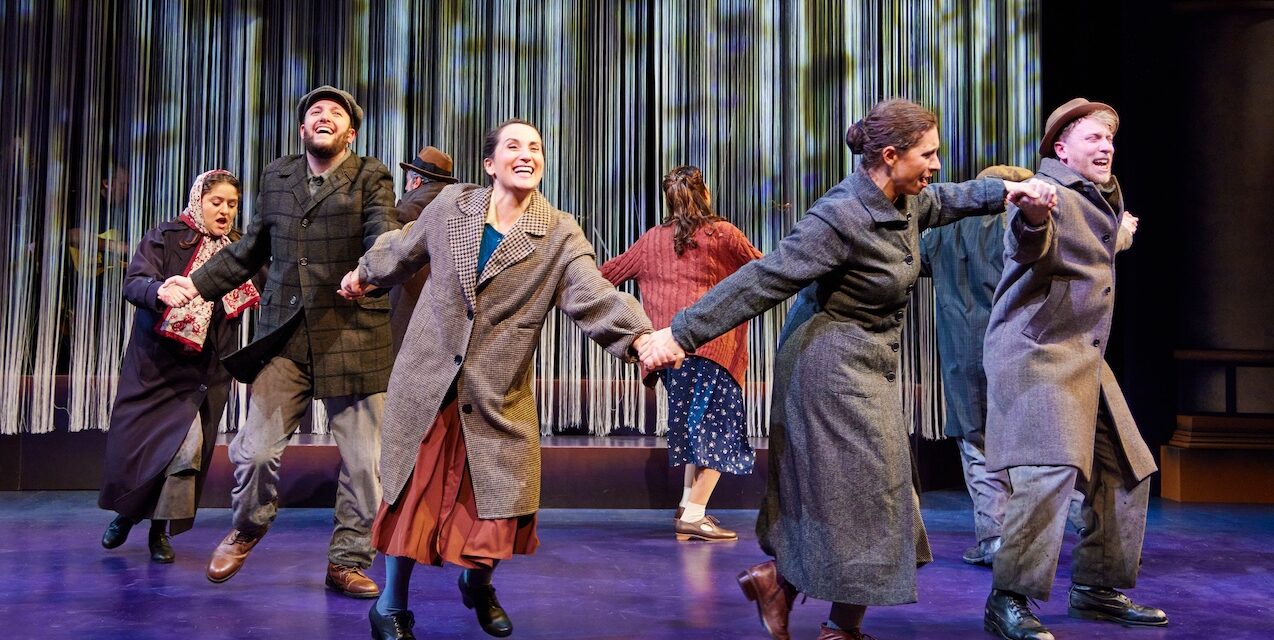Theater Review by Samuel L. Leiter . . . .
It’s a pleasure to report that, with Amid Falling Walls (Tsvishn Falndike Vent), the venerable National Yiddish Theatre Folksbiene yet again demonstrates why it remains one of New York’s most treasured theatrical resources. This captivating show, nearly all of it in Yiddish, will have you wiping away tears with one hand and clapping your knee with the other, even if you don’t know a brokhe from a bris.
A worthy addition to the company’s distinguished list of attractions at the Museum of Jewish Heritage’s Edmond J. Safra Hall, it follows, most recently, their Yiddish-language revival of Fiddler on the Roof and Barry Manilow and Bruce Sussman’s Harmony. The first moved uptown to a major Off-Broadway rendering, while the second, about a partly Jewish group of entertainers oppressed by the Nazis, is now ensconced in Broadway’s Ethel Barrymore Theatre.
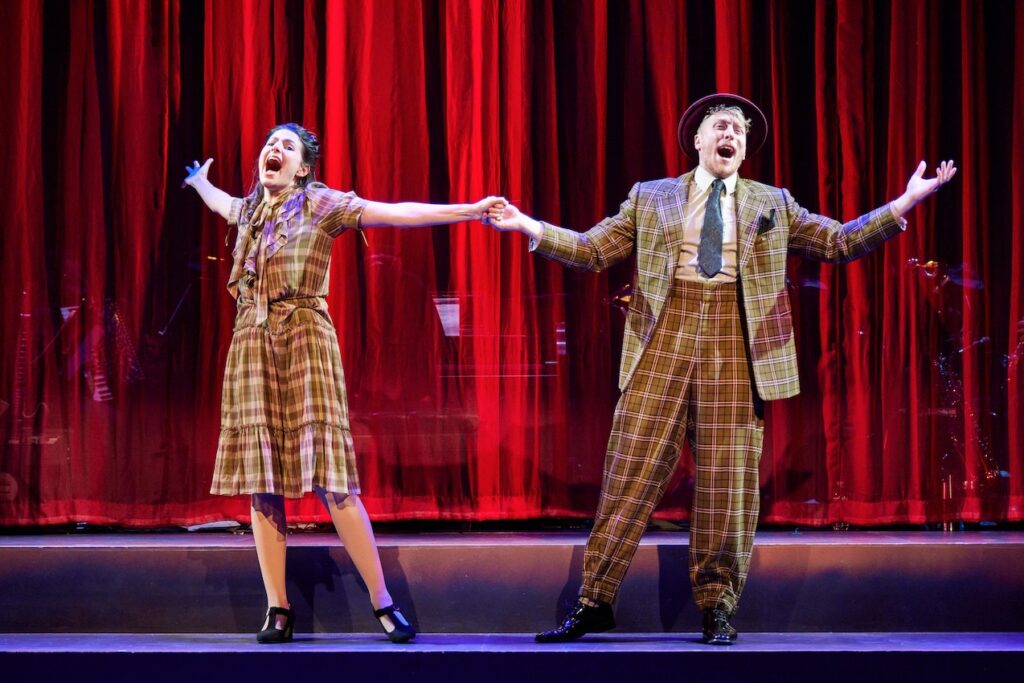
Although Amid Falling Walls is more modest in scale, it’s nonetheless on the same level of professional polish and gripping audience interest. And, like Harmony, it makes a bitingly topical contribution to the ever-growing library of Holocaust-related art by introducing significant, well-researched material, hitherto little known to most theatergoers.
Amid Falling Walls is an 80-minute, intermissionless musical revue co-curated by Zalmen Mlotek, the Folksbiene’s brilliant music director, and Avram Mlotek, with ear-pleasing arrangements by the former and a scrupulously succinct script by the latter. The imaginative direction is by Matthew “Motl” Didner and the expressive choreography is by Tamar Rogoff.
Eight superb performers—Jacob Ben-Shmuel, Yael Eden Chanukov, Abby Goldfarb, Eli Mayer, Daniella Rabbani, Steven Skybell, Mikhl Yashinsky, and Rachel Zatkoff—sing and dance the songs. Skybell, who played Tevye in the company’s Fiddler on the Roof, is the best known, and, true to form, he sings his glorious heart out, but each cast member gets to shine in their own Jewish starlight.
The action moves swiftly from number to number on an open stage—designed by Jessica Alexandra Cancino and smartly lit by Yael Lubetsky—which is backed by a cleverly deployed curtain. Visible behind a diaphanous one situated a bit further upstage are Zalmen Mlotek and his orchestra. Five narrow screens lining each side of the auditorium display—both before the show and during it—numerous black and white still and video images showing European Jews of all classes during the years invoked. Kudos to projection designer Brad Peterson.
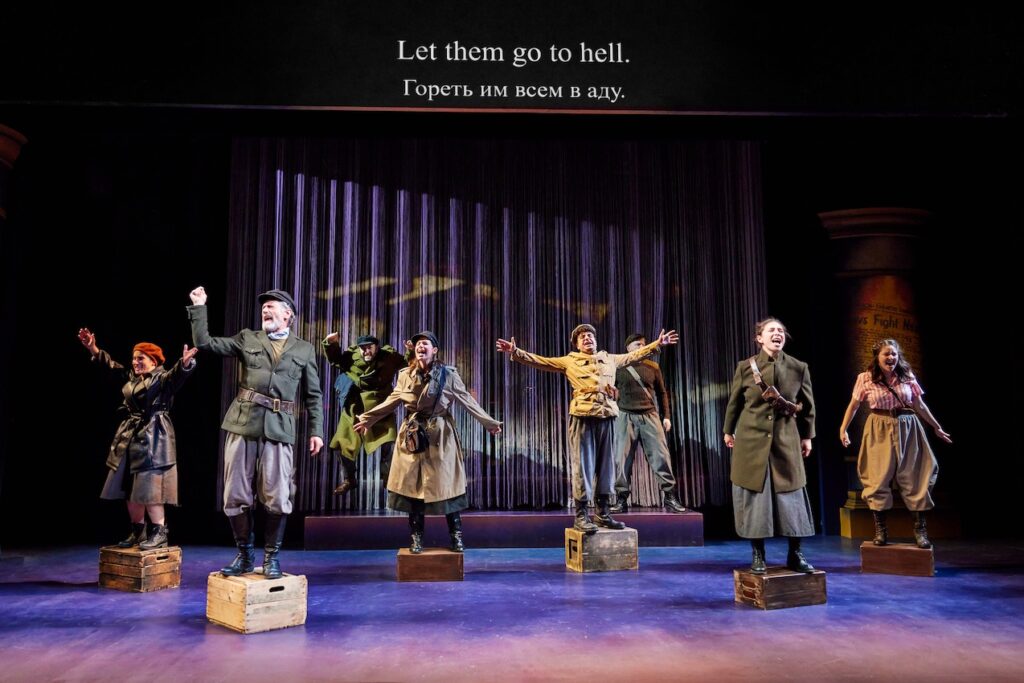

Each routine is inventively staged, some requiring little more than the actor and their space, others some sort of choreographically coordinated relationship with a partner, and others more elaborate group movement, including, even, a kick-line routine. An earlier Zalmen Mlotek show, Ghetto Tango, is credited with the staging template.
For its raw material Amid Falling Walls uses over two dozen Yiddish songs gleaned from several post-World War II collections, chiefly 1948’s Lider Fun di Getos, compiled by Shmerke Kaczerginski from Jews he found in Displaced Persons camps. These were inspired by the circumstances of living under Nazi rule from 1939-1945; the songs, by people ranging in age from their teens to their early 40s, are interspersed with brief bits of poetry and testimony by contemporary Jewish writers collected in sources cited in the program.
The lyrics, some of them emotionally devastating, reflect, with different levels of directness, the oppressive conditions under which Jews were compelled to survive in Europe’s ghettos and, later, forced-labor camps, among other places. That such songs could have been written under such constraints is an homage to the human spirit. Overhead titles in English and Russian overcome the language barrier, while also citing the identity of the contributors and the various locales, such as the ghettos of Warsaw, Lodz, Vilna, and so forth, as well as labor camps and sites of resistance.
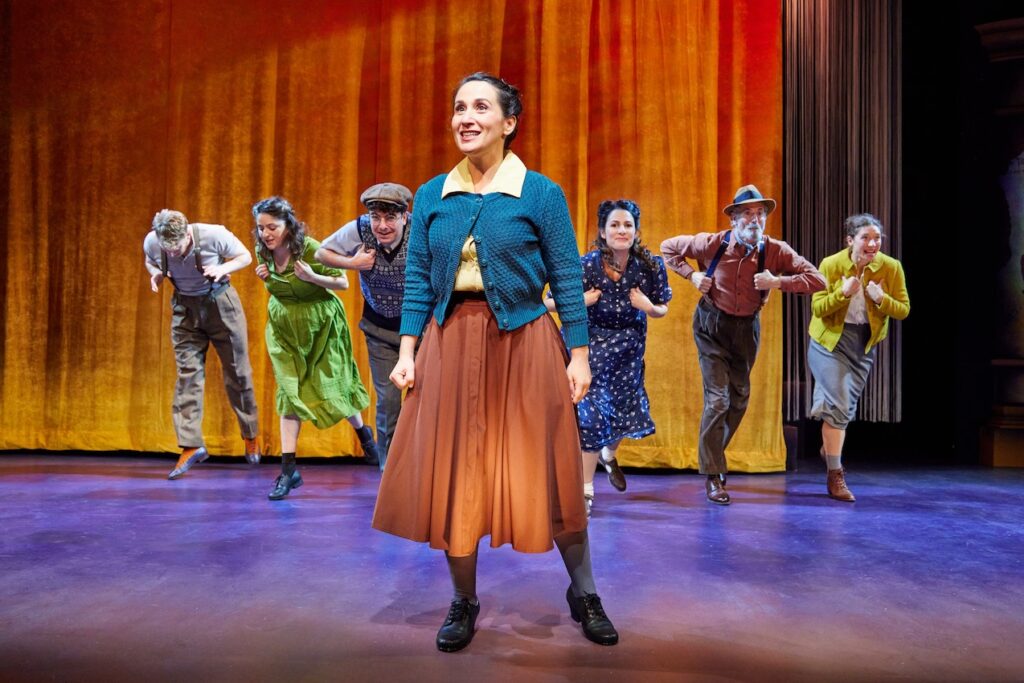

The relatively limited information delivered—such as the multiple restrictions under which Jews were forced to live, and the humiliations and mistreatments to which they were subjected—is not new, of course. However, learning it in the context of a show in which heartbreaking ballads, as well as rousing choral songs that follow each other in rapid succession, intensifies our profound response. Feelings of melancholy, romance, loss, sentimentality, courage, anger, and grief pervade the melodies, their rhythms based on multiple types, including a tango. Yet there’s room for momentary laughter and even joy, albeit always bittersweet.
For an idea of the variations, consider “A Yiddish Kind” (“A Jewish Child”), a tearjerker during which Danielle Rabbani sings about a mother abandoning her little one with a gentile family in order to protect it. In a touching ballad called “Mazl” (“Luck”), Abby Goldfarb sings the words as we see behind her a film in which Yiddish star Molly Picon mouths them. Comic energy informs “Mues” (“Money”), a satirical cabaret-style routine suggestive of Kurt Weill, performed with flamboyantly theatrical panache by Rabbani. As the war progresses and promise is in the air, uplifting songs of resistance, like “Zog Nit Keynmol” (“Never Say”), and persistence, like “Mir Lebn Eybik!” (“We Live Forever”), make their rousing appearance. As a bonus, the very helpful program provides notes on the provenance of each number.
Cabaret is a strong influence as many songs were originally heard in such shows, or in conventional theatrical performances, often given under clandestine conditions. This is a situation the show is anxious to convey so as to demonstrate how the Jews managed, for a time, to operate subversively.
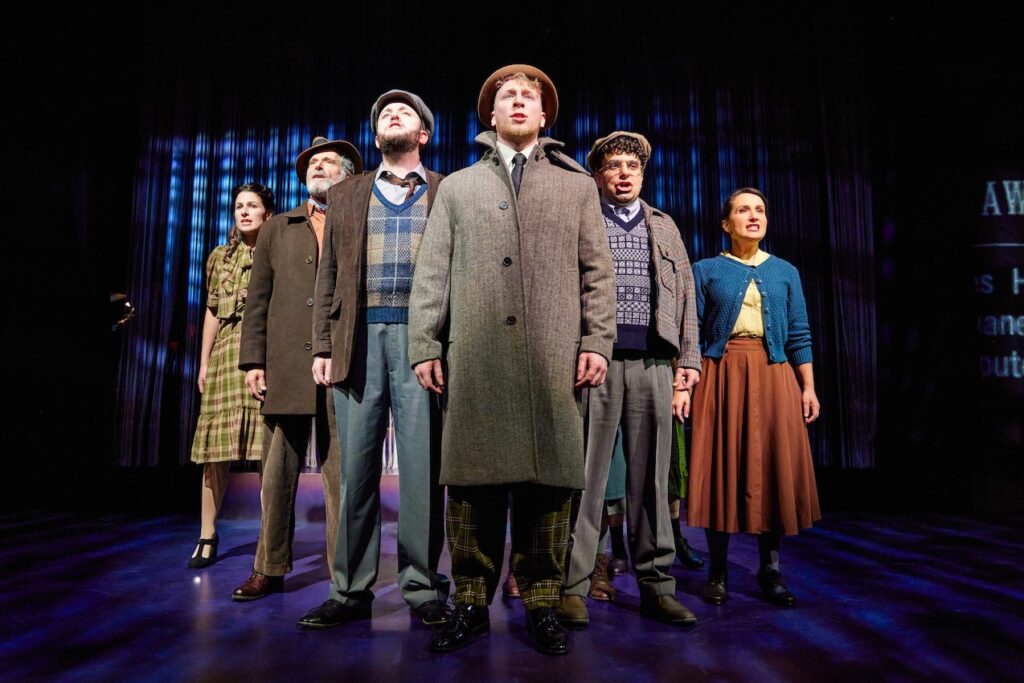

The players, representing persons from teens to middle-aged, have been given character names, but this really isn’t necessary as—given the time that passes and the disparate places represented—it’s impossible to assign identities to them. It wasn’t until I looked at the program afterward that I even realized each actor had been thus labeled. Costumer Izzy Fields, however, has provided each of them with several period costumes to mark their journey from lamentation about their situation to partisan defiance, when those who could joined armed resistance groups, their spirit evoked in vigorous agitprop-like staging.
It must be noted that a show like Amid Falling Walls, produced at an internationally tense moment such as the present one, is going to generate mixed responses, regardless of how fine it is or how much sympathy it stirs for the people and tragedy it memorializes. For example, given the complexities of the circumstances, some, perhaps, will even sense a touch of irony in it. This is, after all, a work in which the characters bemoan the subjugation under which they’re forced by an occupying power to live; their inability to leave; and the unwillingness of other nations to intrude. Ultimately, they rise up and take what measures they can against their mightier oppressors.
Putting today’s politics aside—assuming that’s even possible—Amid Falling Walls is absolutely worth a trip to Battery Park. You don’t need to know Yiddish to love it, and you’ll probably come to feel that without Yiddish it would lose half its power to move you.
Amid Falling Walls. Through December 10 at the Edmond J. Safra Hall/Museum of Jewish Heritage (36 Battery Park in Lower Manhattan). www.nytf.org
Photos: Jeremy Daniel


